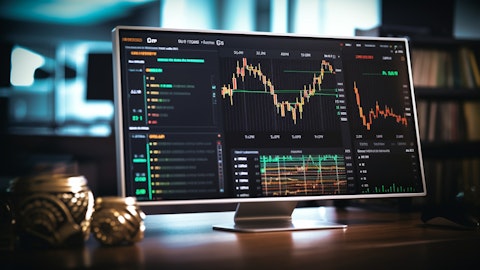Operator: Your next question comes from the line of Owen Lau with Oppenheimer. Your line is open.
Owen Lau: Hi. Good afternoon. Thank you for taking my question. At the House hearing yesterday, Undersecretary confirmed with Congressman Tom Emmer that a report about Hamas using digital assets to raise fund was inaccurate, and crypto was not even a popular tool for terrorists. Even though Chainalysis, put a report to correct that record, it doesn’t appear that it gets enough attention. So I have two questions here. Could you please talk about Coinbase investments in anti-money laundering program to protect your customers and also your reaction to that conversation? Thank you.
Alesia Haas: Thanks, Owen, and thanks for noticing that. We were really pleased to see that house hearing yesterday and really pleased with the correction of the record here. One, we have significant investments in AML. We have a large compliance team that has best-in-class compliance approaches the same as any other fintech or bank. We follow very standard rules in this place and are governed by our MTL licenses and our Bitcoin license with NYDFS. We’re really proud to be one of the most compliant crypto companies, frankly, in the world with this regard. I will share how Paul’s share reaction to the hearing and maybe I’ll pass it over to you, Paul.
Paul Grewal: Thanks, Alesia. We were very pleased to see the Congress pay careful attention to this issue. French Hill, Chair of the Subcommittee could not have been clear when he observed that the treasury Undersecretary made explicit what we have been saying all along, which is that bad actors still prefer to use traditional finance rather than digital assets to fund their activities. That I think was an important validation of something that we’ve been saying for a very, very long time. And Mr. Nelson, the UnderSecretary also confirmed that prior reports that have been published that successful international collaboration with Israeli law enforcement had limited Hamas and its use of its digital assets ahead of the attack against Israel. So we think that the facts are clear. And we are pleased that when confronted with those facts, the Congress is underscoring that crypto is an answer to the problem of illicit finance. It is not solely the problem.
Operator: Your next question comes from the line of John Todaro with Needham & Company. Your line is open.
John Todaro: Thanks for taking my question. First off, congrats on the quarter, pretty great results here. I have two questions on the institutional business. So it looks like take rate there went up. Trying to understand what drove that or if there was some other revenue that went into that institutional revenue, whether that was base chain or derivatives? And then second, as we think about Q1 2024, had the Bitcoin ETFs, has that driven more institutional activity on the platform where moving forward, we should think of institution as a greater makeup share of the total volume?
Alesia Haas: Thanks for the question, John. So embedded in our institutional product revenues are really two products. One is the markets business, which is our exchange, where we have market makers and liquidity providers transacting directly on the exchange and the other is Coinbase Prime. Coinbase Prime has a higher fee rate than the exchange. And so similar to the consumer side, we see mix shift driving the blended average fee rate on institutional. And we’re seeing strong growth of Coinbase Prime, and it had a larger share of volume in Q4, which drove the increase in that fee rate in the fourth quarter. Going to your second question on have Bitcoin ETFs driven more into activity. As we shared earlier and Brian shared in his response, ETFs have just been net positive for the industry and additive to Coinbase. And we’re seeing elevated engagement and net inflows on institutional as well as retail Q1 to date.
Operator: Your next question comes from the line of Devin Ryan with JMP Securities. Your line is open.
Devin Ryan: Great. Thank you so much. From what I can track, you guys have seen a very sizable acceleration in derivatives volumes even in recent weeks, it seems like it’s been accelerating quite a bit on the international exchange. So nice to see the momentum there. And obviously, we know the derivatives market is larger than the spot market. So I guess, first off, how would you frame the scaling that you’re experiencing already relative to how you’re thinking about the broader potential longer term? And then second, what is the user profile on take rate look like there now? And then where do you see that user mix and take rate moving over time as it matures? Thanks.
Brian Armstrong: I can start off on derivatives and then Alesia, maybe I’ll turn it to you on some of the take rate question. So thanks for tracking. We have been hitting daily all-time highs on our international exchange which has been really great. It’s still early days, just to be clear, but the market, I think, has really demonstrated they want to see a trusted counterparty here built in a compliant way. And Coinbase is really the first company they’ve seen come along that fits that definition. So we’ve been making a lot of progress on our International derivatives exchange. We added 11 new markets in Q4. We’re now up to about 70% of global TAM. We announced that we’re acquiring a MiFID license that will help us unlock derivatives in about 20 additional EU member states.





